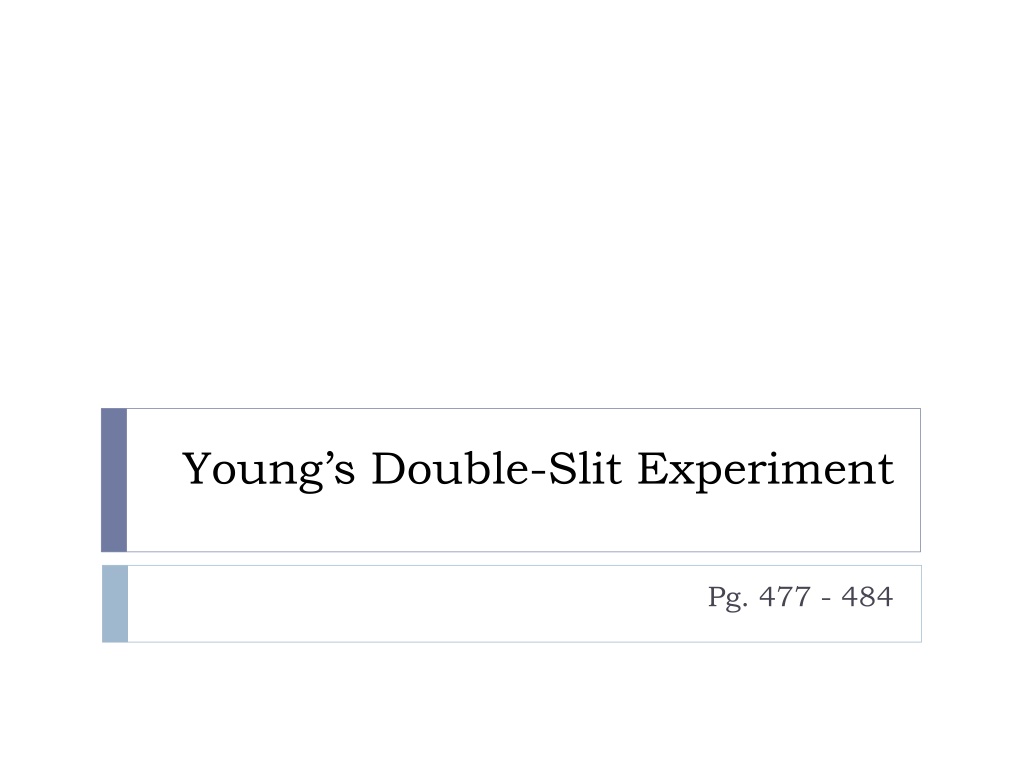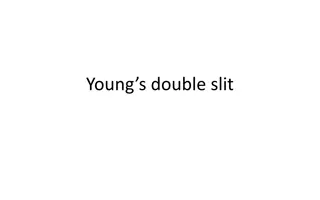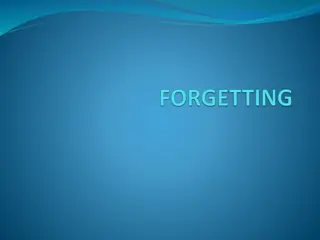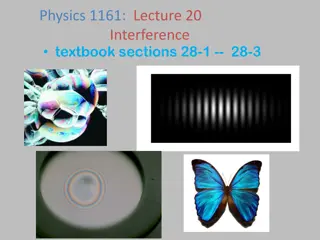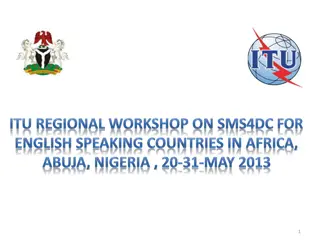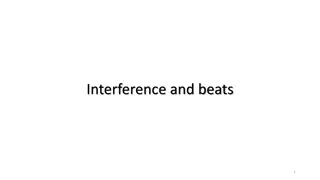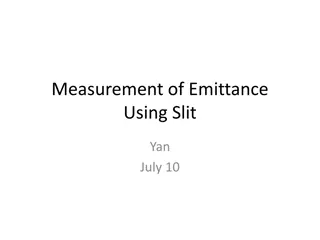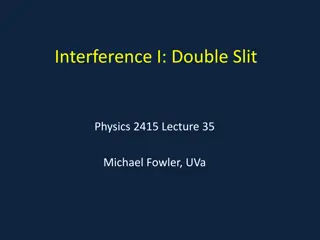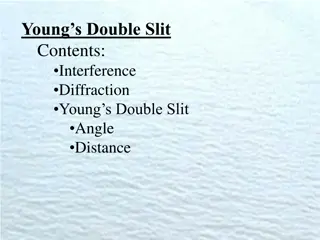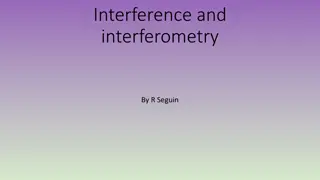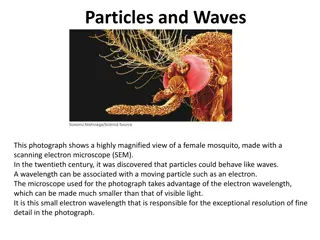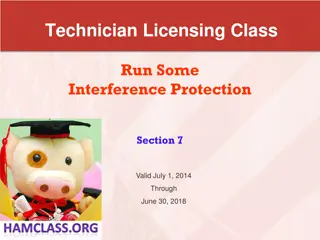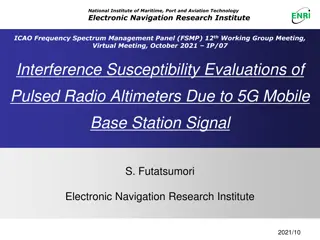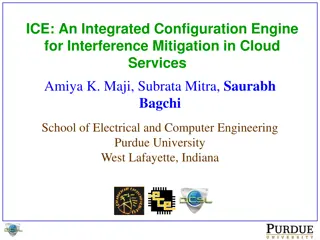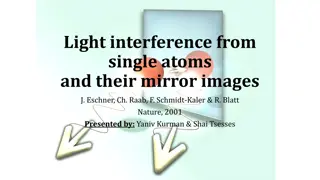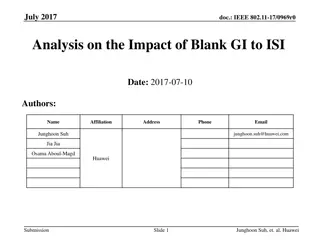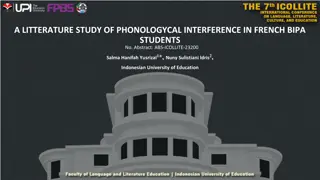Understanding Young's Double-Slit Experiment and Interference Patterns
Thomas Young's double-slit experiment in the late 1700s provided evidence of light behaving as a wave, showcasing interference patterns. This experiment challenged the particle theory of light and supported the wave theory. The interference patterns observed helped scientists grasp the wave nature of light and revolutionized our understanding of light behavior. The experiment highlighted the coherence of light passing through narrow slits and illuminated the debate between particle and wave theories.
Download Presentation

Please find below an Image/Link to download the presentation.
The content on the website is provided AS IS for your information and personal use only. It may not be sold, licensed, or shared on other websites without obtaining consent from the author. Download presentation by click this link. If you encounter any issues during the download, it is possible that the publisher has removed the file from their server.
E N D
Presentation Transcript
Youngs Double-Slit Experiment Pg. 477 - 484
Interference We now know that the experiments failed for two simple but important reasons: 1. Atoms send out a burst of light energy about every 10-8 s so the probability that the atoms in each source would emit their light waves in phase is nearly zero the result is an interference pattern that changes in an irregular fashion and is impossible to see 2. Compared to the wavelength of light, the distance between the sources was much too large the result is light and dark areas on the screen that are too close together to be observed.
Particle Theory vs. Wave Theory At the end of the 1600s and into the 1700s, the debate was in full swing During this time, many researchers focused on the question of interference If light travels like a wave, a similar experiment using two light sources should reveal bright areas (constructive interference) and dark areas (destructive interference) on a screen However, researchers could not detect it
Interference These conditions were difficult for scientists to create in the 1700s Since scientists did not even know whether light behaved like a particle or a wave, they had no way of knowing what the wavelength might be It took nearly 100 years after Newton and Huygens for the debate to be resolved
Youngs Double-Slit Experiment At the end of the 1700s, Thomas Young devised an experiment that produced an interference pattern with light Using one monochromatic light source, Young allowed the light to fall onto an opaque material with a single, narrow slit
Youngs Double-Slit Experiment According to Hyugens principle, this slit acted as a new source The light passing through the single slit spread as it travelled to a second opaque barrier that had two narrow slits placed very close together As a result, the light leaving the double slits was essentially coherent
Youngs Double-Slit Experiment The light that passed through the double-slit barrier fell on a nearby screen, producing the historic pattern of light and dark lines caused by the interference of light waves Young s results catapulted the wave model for light into centre stage, where it remained unchallenged for more than 100 years
Video : http://www.youtube.com/watch?v=Iuv6hY6zsd0 Note: Young experimented with this set-up for more than two years before he realized that the double slits had to be so close together that they almost appeared as one slit to the naked eye
Youngs Double-Slit Experiment Young was successful because: 1. He used a monochromatic (single wavelength) light source 2. The double slits acted as two sources and were spread much more closely together than possible if two separate light sources were used 3. The light passing through the initial slit acted as a point source. When a wave front from the point source reached the double slits, two parts of the same wave front became new sources for the double slits and were therefore coherent.
Youngs Double Slit Experiment (note) Early attempts to show the interference of light were unsuccessful because: The sources were not coherent, and The sources were too far apart Young was successful for three mains reasons: He used monochromatic (single wavelength) light source The double slits were very close together The double slits acted as two point sources that were coherent (i.e. in phase) Produced a series of light and dark fringes on a screen placed in the path of the light Pattern resembled the results of the interference of water waves in a ripple tank Was evidence for the wave nature of light
Youngs Double-Slit Experiment Take note: The bright and dark fringes are alternate regions of constructive and destructive interference To analyze interference, you need to determine the path length difference between each slit and the screen
Youngs Double-Slit Experiment To simplify the analysis, we assume that: 1. the screen is a long way from the slits and so L > > d 2. Since L >>d, the path length L1 and L2 are nearly parallel 3. Since L1 and L2 are nearly parallel, the angles of the path lengths L1 and L2 from each of the slits to the point P on the screen are approximately equal 4. the wavelength is much smaller than d
Youngs Double-Slit Experiment Since the slits are separated by a distance, d, the path length different between L1 and L2, are given by:
Practice 1. The third-order dark fringe of 660 nm light is observed at an angle of 20.0 degrees when the light falls on the two narrow slits. Determine the slit separation. (d = 4.8 x 10- 6m)
Youngs Double-Slit Experiment In addition, the equation to determine the distance of each bright fringe form the centre of the screen (m = 0) is: determine the distance of each dark fringe from the centre of the screen is:
Practice 2. Two slits are separated by 0.20 mm and produce an interference pattern. The fifth maximum is 12.8 cm from the central maximum. The wavelength of the light used is 550 nm. Determine the distance at which the screen is placed. (L = 9.3 m)
Youngs Double-Slit Experiment In either case, the separation between any two adjacent fringes is: which can be rearranged to determine the approximate wavelength of light:
Practice 3. A double-slit experiment is carried out with slit spacing d = 0.41 mm. The screen is at a distance of 1.5 m. The bright fringes at the centre of the screen are separated by a distance of x = 1.5 mm. a) Determine the wavelength of the light (4.1 x 10-7m) b) Determine the spacing of the bright fringes when a source with a wavelength 600 nm is used. (2.2 x 10-3m) In an interference experiment, red light (600 nm) passes through a double slit. On a screen 1.5 m away, the distance between the 1st and 11thdark banks is 13.2 cm. a) what is the spacing between adjacent nodal lines? x = 1.32 cm (11 lines = 10x) b) what is the separation of the slits? (d = 6.8 x 10-5m) c) what would the spacing be, between adjacent nodal lines, if blue light (450 nm) were used? (x = 9.9 x 10-3m) 4.
More Developments in the Theory of Light Young s evidence for the wave nature of light was not accepted by the scientific community until 1818, when Augustin Fresnel proposed his own wave theory, complete with the mathematics A mathematician named Simon Poisson showed how Fresnel s equations predicted a unique pattern when light is projected past a small solid object, as shown below.
More Developments in the Theory of Light Poisson s argument was that, if light behaved as a wave, then the light diffracting around the edges of the disc should interfere constructively to produce a bright spot at the centre of the diffraction pattern This was impossible according to the particle theory of light
Practice 5. So, is light a wave or a particle? Textbook Pg. 482, #1-3 Pg. 484, #1,2, 5
